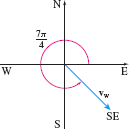EXAMPLE 8Using Standard Basis Vectors to Model a Problem
An airplane has an air speed of 400 km/h and is headed east. There is a northwesterly wind of 80 km/h. (Northwesterly winds blow toward the southeast.)
- (a) Find a vector representing the velocity of the airplane in the air.
- (b) Find a vector representing the wind velocity.
- (c) Find a vector representing the velocity of the airplane relative to the ground.
- (d) Find the true speed of the airplane.
Solution We use a two-dimensional coordinate system with the direction north along the positive y-axis. Then the direction east is along the positive x-axis.
Using a scale of 1 unit=1 km/h, define va=Velocity of the airplane in the airvw=Velocity of the windvg=Velocity of the airplane relative to the ground
Figure 31 shows the vectors va, vw, vg.
- (a) The vector va has magnitude 400 and direction i, so va = 400i.
- (b) The vector vw has magnitude 80 and makes an angle of 7π4 with the positive x-axis, as shown in Figure 32. Since the magnitude of vw is 80, vw=80(cos7π4i+sin7π4j)=80(√22i−√22j)=40√2i−40√2j
- (c) The velocity vg of the airplane relative to the ground is the resultant of va and vw. vg=va+vw=400 i+[40√2i−40√2j]=(400+40√2)i−40√2j
- (d) The true speed of the airplane is the magnitude of the vector vg. ‖
The true speed of the airplane is approximately 460.060 \,\rm{km/h}.

